WS 4503: Mental Health and Wellbeing of Indigenous Australians
VerifiedAdded on 2023/01/20
|11
|2921
|40
Essay
AI Summary
This essay delves into the complex issues surrounding the social and mental health of Indigenous Australians. It begins by defining mental health and wellbeing, then examines the impact of social policies and the historical context of mental health care in Australia. The essay highlights the disproportionately high rates of mental illness among Aboriginal and Torres Strait Islander peoples, attributing this to factors such as colonization, racism, and social exclusion. It explores the medical, social science, and bio-psycho-social models of mental health, and the evolution of mental health treatment practices in Australia. Furthermore, it addresses the gaps in current policies, including cultural barriers and the lack of access to services, proposing solutions to improve mental health outcomes within Indigenous communities. The essay also discusses the importance of social justice, human rights, and the role of social work in advocating for the wellbeing of Indigenous Australians, emphasizing the need for culturally sensitive and community-based approaches to mental health care.
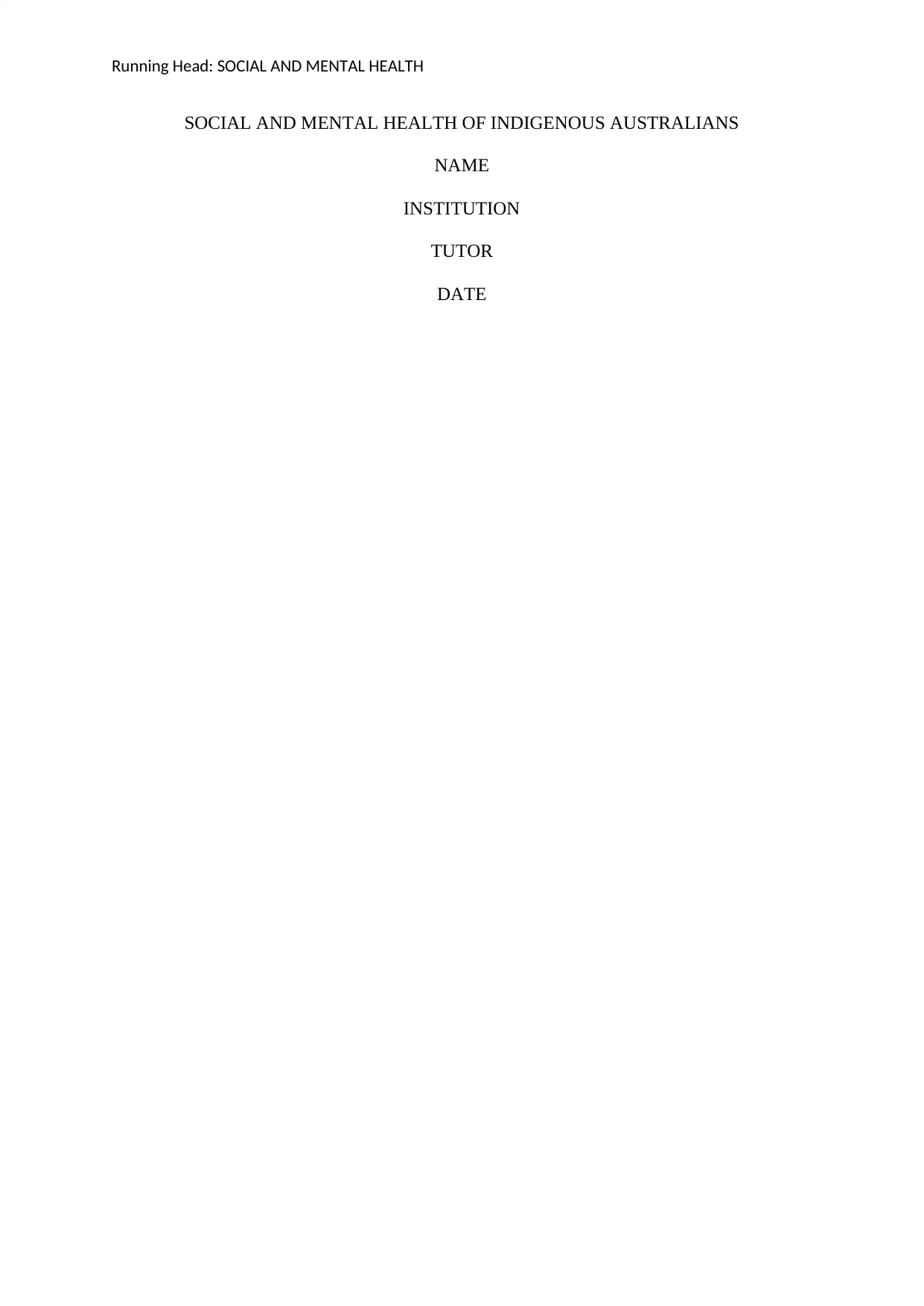
Running Head: SOCIAL AND MENTAL HEALTH
SOCIAL AND MENTAL HEALTH OF INDIGENOUS AUSTRALIANS
NAME
INSTITUTION
TUTOR
DATE
SOCIAL AND MENTAL HEALTH OF INDIGENOUS AUSTRALIANS
NAME
INSTITUTION
TUTOR
DATE
Paraphrase This Document
Need a fresh take? Get an instant paraphrase of this document with our AI Paraphraser
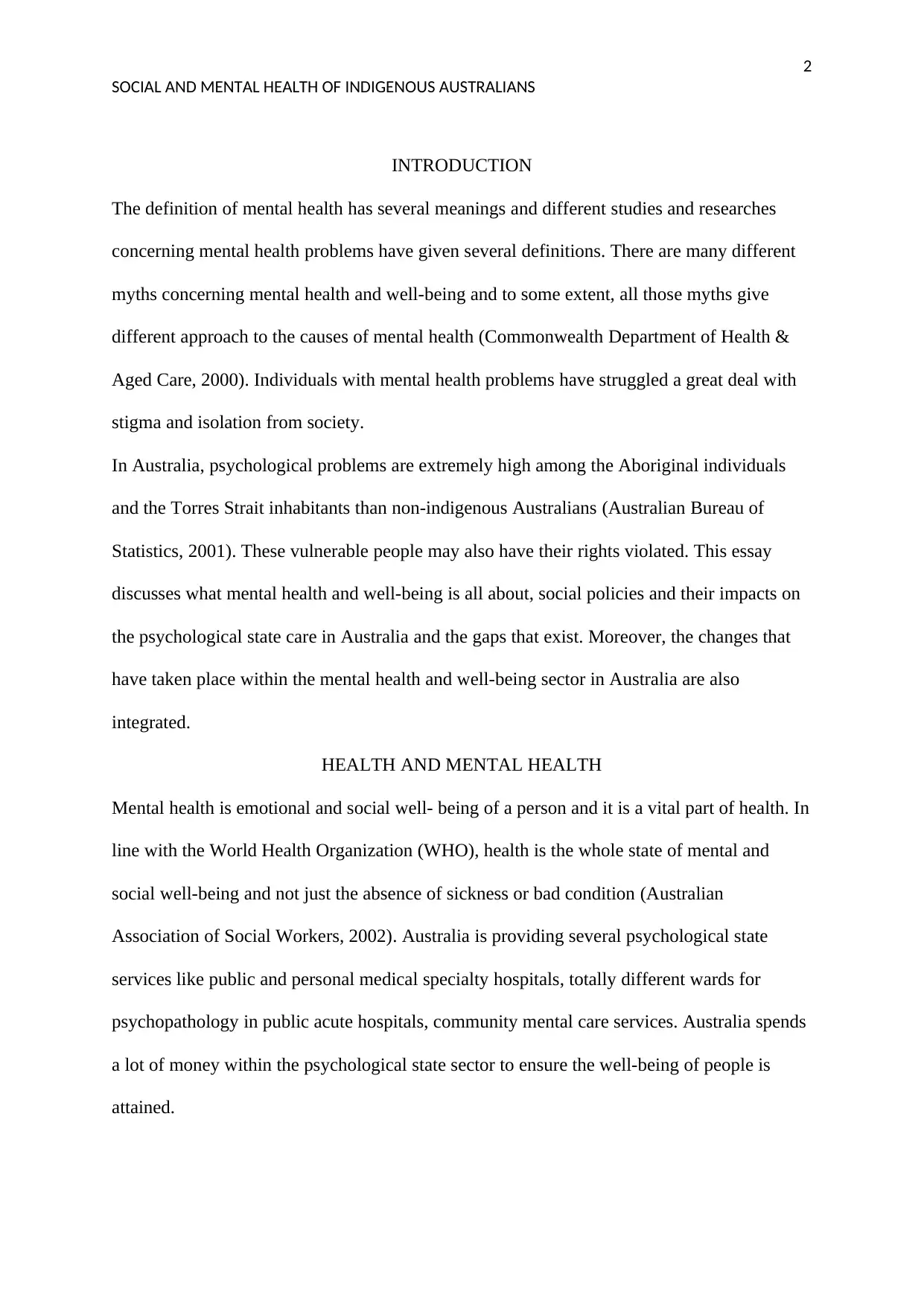
2
SOCIAL AND MENTAL HEALTH OF INDIGENOUS AUSTRALIANS
INTRODUCTION
The definition of mental health has several meanings and different studies and researches
concerning mental health problems have given several definitions. There are many different
myths concerning mental health and well-being and to some extent, all those myths give
different approach to the causes of mental health (Commonwealth Department of Health &
Aged Care, 2000). Individuals with mental health problems have struggled a great deal with
stigma and isolation from society.
In Australia, psychological problems are extremely high among the Aboriginal individuals
and the Torres Strait inhabitants than non-indigenous Australians (Australian Bureau of
Statistics, 2001). These vulnerable people may also have their rights violated. This essay
discusses what mental health and well-being is all about, social policies and their impacts on
the psychological state care in Australia and the gaps that exist. Moreover, the changes that
have taken place within the mental health and well-being sector in Australia are also
integrated.
HEALTH AND MENTAL HEALTH
Mental health is emotional and social well- being of a person and it is a vital part of health. In
line with the World Health Organization (WHO), health is the whole state of mental and
social well-being and not just the absence of sickness or bad condition (Australian
Association of Social Workers, 2002). Australia is providing several psychological state
services like public and personal medical specialty hospitals, totally different wards for
psychopathology in public acute hospitals, community mental care services. Australia spends
a lot of money within the psychological state sector to ensure the well-being of people is
attained.
SOCIAL AND MENTAL HEALTH OF INDIGENOUS AUSTRALIANS
INTRODUCTION
The definition of mental health has several meanings and different studies and researches
concerning mental health problems have given several definitions. There are many different
myths concerning mental health and well-being and to some extent, all those myths give
different approach to the causes of mental health (Commonwealth Department of Health &
Aged Care, 2000). Individuals with mental health problems have struggled a great deal with
stigma and isolation from society.
In Australia, psychological problems are extremely high among the Aboriginal individuals
and the Torres Strait inhabitants than non-indigenous Australians (Australian Bureau of
Statistics, 2001). These vulnerable people may also have their rights violated. This essay
discusses what mental health and well-being is all about, social policies and their impacts on
the psychological state care in Australia and the gaps that exist. Moreover, the changes that
have taken place within the mental health and well-being sector in Australia are also
integrated.
HEALTH AND MENTAL HEALTH
Mental health is emotional and social well- being of a person and it is a vital part of health. In
line with the World Health Organization (WHO), health is the whole state of mental and
social well-being and not just the absence of sickness or bad condition (Australian
Association of Social Workers, 2002). Australia is providing several psychological state
services like public and personal medical specialty hospitals, totally different wards for
psychopathology in public acute hospitals, community mental care services. Australia spends
a lot of money within the psychological state sector to ensure the well-being of people is
attained.
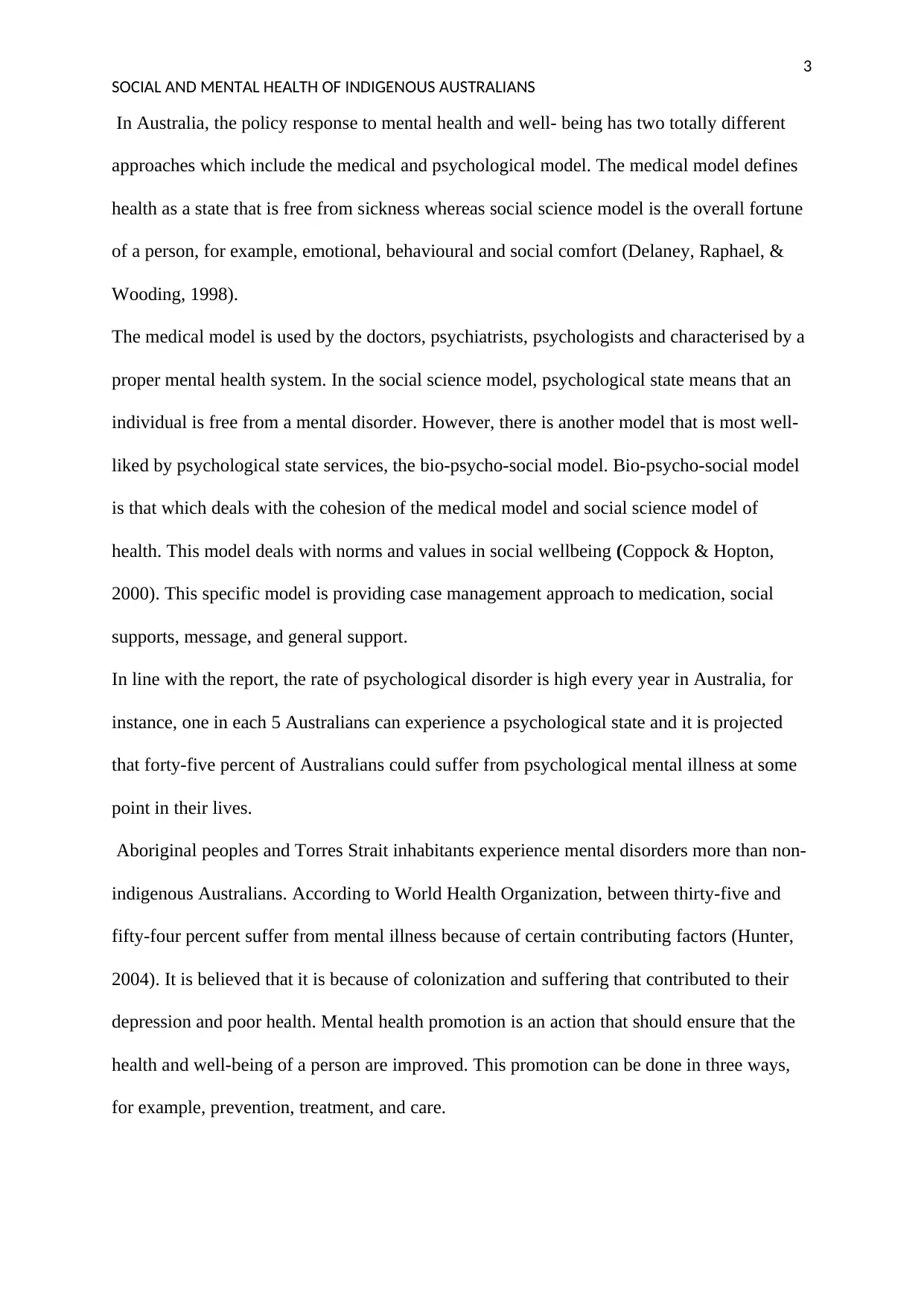
3
SOCIAL AND MENTAL HEALTH OF INDIGENOUS AUSTRALIANS
In Australia, the policy response to mental health and well- being has two totally different
approaches which include the medical and psychological model. The medical model defines
health as a state that is free from sickness whereas social science model is the overall fortune
of a person, for example, emotional, behavioural and social comfort (Delaney, Raphael, &
Wooding, 1998).
The medical model is used by the doctors, psychiatrists, psychologists and characterised by a
proper mental health system. In the social science model, psychological state means that an
individual is free from a mental disorder. However, there is another model that is most well-
liked by psychological state services, the bio-psycho-social model. Bio-psycho-social model
is that which deals with the cohesion of the medical model and social science model of
health. This model deals with norms and values in social wellbeing (Coppock & Hopton,
2000). This specific model is providing case management approach to medication, social
supports, message, and general support.
In line with the report, the rate of psychological disorder is high every year in Australia, for
instance, one in each 5 Australians can experience a psychological state and it is projected
that forty-five percent of Australians could suffer from psychological mental illness at some
point in their lives.
Aboriginal peoples and Torres Strait inhabitants experience mental disorders more than non-
indigenous Australians. According to World Health Organization, between thirty-five and
fifty-four percent suffer from mental illness because of certain contributing factors (Hunter,
2004). It is believed that it is because of colonization and suffering that contributed to their
depression and poor health. Mental health promotion is an action that should ensure that the
health and well-being of a person are improved. This promotion can be done in three ways,
for example, prevention, treatment, and care.
SOCIAL AND MENTAL HEALTH OF INDIGENOUS AUSTRALIANS
In Australia, the policy response to mental health and well- being has two totally different
approaches which include the medical and psychological model. The medical model defines
health as a state that is free from sickness whereas social science model is the overall fortune
of a person, for example, emotional, behavioural and social comfort (Delaney, Raphael, &
Wooding, 1998).
The medical model is used by the doctors, psychiatrists, psychologists and characterised by a
proper mental health system. In the social science model, psychological state means that an
individual is free from a mental disorder. However, there is another model that is most well-
liked by psychological state services, the bio-psycho-social model. Bio-psycho-social model
is that which deals with the cohesion of the medical model and social science model of
health. This model deals with norms and values in social wellbeing (Coppock & Hopton,
2000). This specific model is providing case management approach to medication, social
supports, message, and general support.
In line with the report, the rate of psychological disorder is high every year in Australia, for
instance, one in each 5 Australians can experience a psychological state and it is projected
that forty-five percent of Australians could suffer from psychological mental illness at some
point in their lives.
Aboriginal peoples and Torres Strait inhabitants experience mental disorders more than non-
indigenous Australians. According to World Health Organization, between thirty-five and
fifty-four percent suffer from mental illness because of certain contributing factors (Hunter,
2004). It is believed that it is because of colonization and suffering that contributed to their
depression and poor health. Mental health promotion is an action that should ensure that the
health and well-being of a person are improved. This promotion can be done in three ways,
for example, prevention, treatment, and care.
⊘ This is a preview!⊘
Do you want full access?
Subscribe today to unlock all pages.

Trusted by 1+ million students worldwide
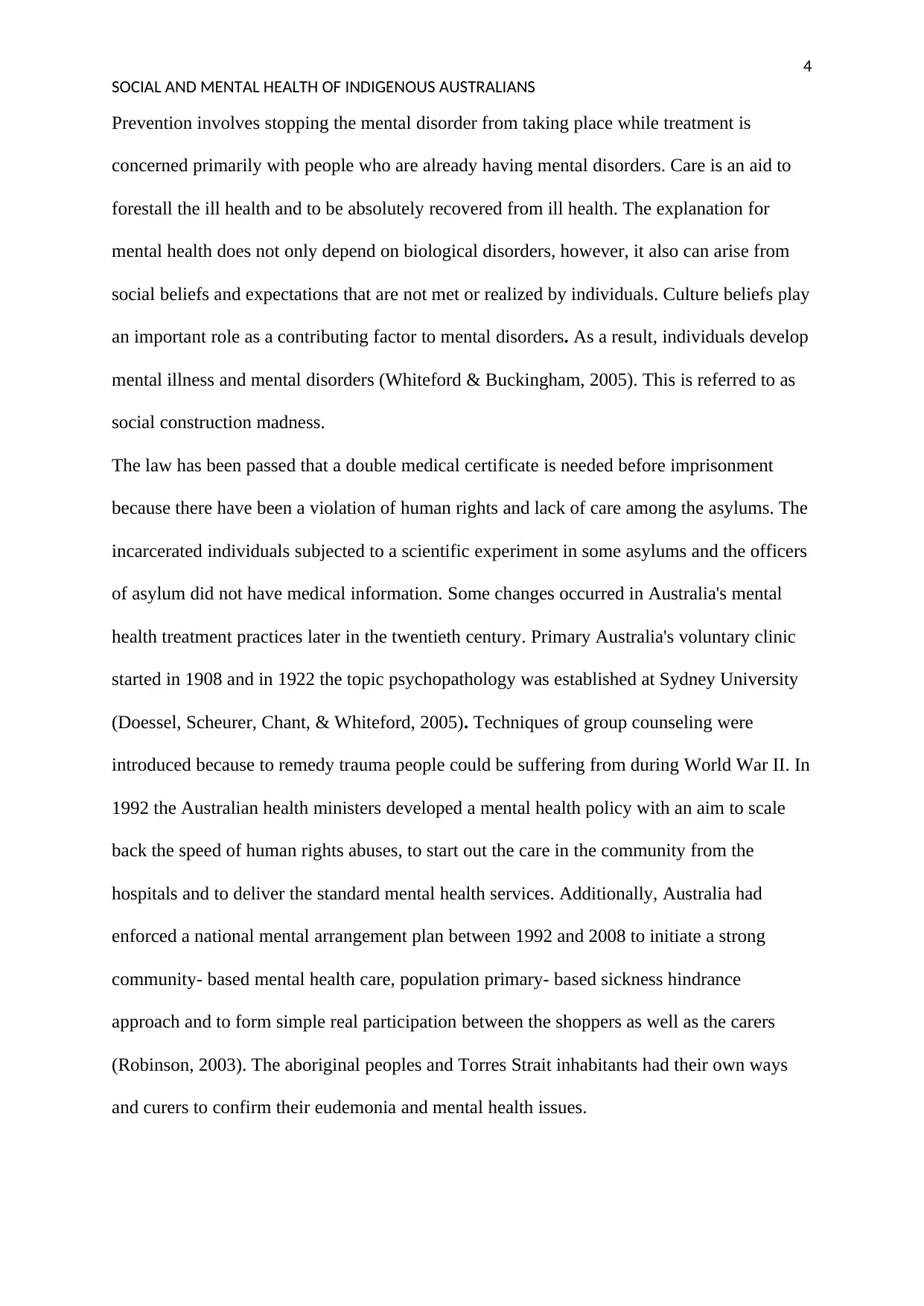
4
SOCIAL AND MENTAL HEALTH OF INDIGENOUS AUSTRALIANS
Prevention involves stopping the mental disorder from taking place while treatment is
concerned primarily with people who are already having mental disorders. Care is an aid to
forestall the ill health and to be absolutely recovered from ill health. The explanation for
mental health does not only depend on biological disorders, however, it also can arise from
social beliefs and expectations that are not met or realized by individuals. Culture beliefs play
an important role as a contributing factor to mental disorders. As a result, individuals develop
mental illness and mental disorders (Whiteford & Buckingham, 2005). This is referred to as
social construction madness.
The law has been passed that a double medical certificate is needed before imprisonment
because there have been a violation of human rights and lack of care among the asylums. The
incarcerated individuals subjected to a scientific experiment in some asylums and the officers
of asylum did not have medical information. Some changes occurred in Australia's mental
health treatment practices later in the twentieth century. Primary Australia's voluntary clinic
started in 1908 and in 1922 the topic psychopathology was established at Sydney University
(Doessel, Scheurer, Chant, & Whiteford, 2005). Techniques of group counseling were
introduced because to remedy trauma people could be suffering from during World War II. In
1992 the Australian health ministers developed a mental health policy with an aim to scale
back the speed of human rights abuses, to start out the care in the community from the
hospitals and to deliver the standard mental health services. Additionally, Australia had
enforced a national mental arrangement plan between 1992 and 2008 to initiate a strong
community- based mental health care, population primary- based sickness hindrance
approach and to form simple real participation between the shoppers as well as the carers
(Robinson, 2003). The aboriginal peoples and Torres Strait inhabitants had their own ways
and curers to confirm their eudemonia and mental health issues.
SOCIAL AND MENTAL HEALTH OF INDIGENOUS AUSTRALIANS
Prevention involves stopping the mental disorder from taking place while treatment is
concerned primarily with people who are already having mental disorders. Care is an aid to
forestall the ill health and to be absolutely recovered from ill health. The explanation for
mental health does not only depend on biological disorders, however, it also can arise from
social beliefs and expectations that are not met or realized by individuals. Culture beliefs play
an important role as a contributing factor to mental disorders. As a result, individuals develop
mental illness and mental disorders (Whiteford & Buckingham, 2005). This is referred to as
social construction madness.
The law has been passed that a double medical certificate is needed before imprisonment
because there have been a violation of human rights and lack of care among the asylums. The
incarcerated individuals subjected to a scientific experiment in some asylums and the officers
of asylum did not have medical information. Some changes occurred in Australia's mental
health treatment practices later in the twentieth century. Primary Australia's voluntary clinic
started in 1908 and in 1922 the topic psychopathology was established at Sydney University
(Doessel, Scheurer, Chant, & Whiteford, 2005). Techniques of group counseling were
introduced because to remedy trauma people could be suffering from during World War II. In
1992 the Australian health ministers developed a mental health policy with an aim to scale
back the speed of human rights abuses, to start out the care in the community from the
hospitals and to deliver the standard mental health services. Additionally, Australia had
enforced a national mental arrangement plan between 1992 and 2008 to initiate a strong
community- based mental health care, population primary- based sickness hindrance
approach and to form simple real participation between the shoppers as well as the carers
(Robinson, 2003). The aboriginal peoples and Torres Strait inhabitants had their own ways
and curers to confirm their eudemonia and mental health issues.
Paraphrase This Document
Need a fresh take? Get an instant paraphrase of this document with our AI Paraphraser
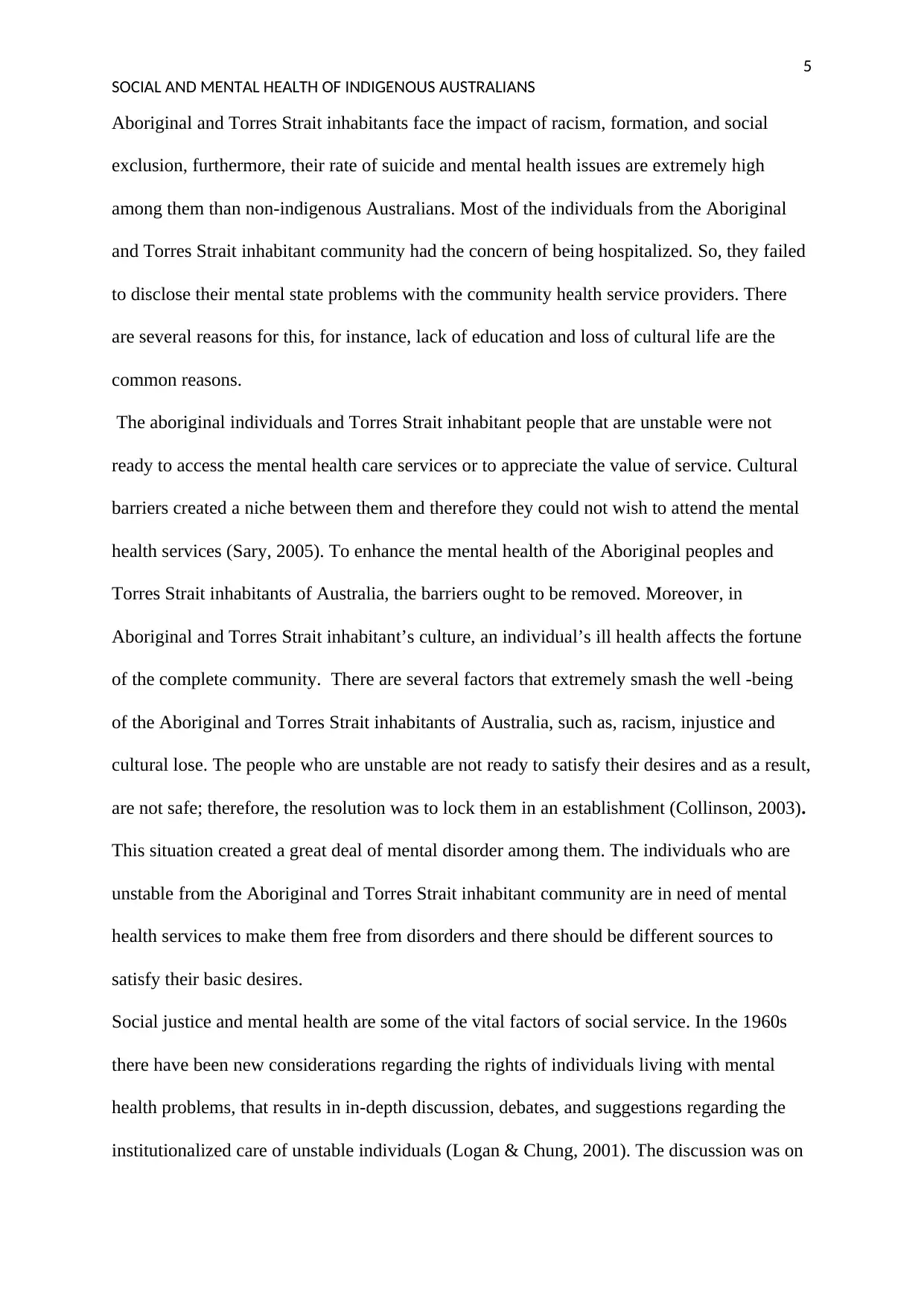
5
SOCIAL AND MENTAL HEALTH OF INDIGENOUS AUSTRALIANS
Aboriginal and Torres Strait inhabitants face the impact of racism, formation, and social
exclusion, furthermore, their rate of suicide and mental health issues are extremely high
among them than non-indigenous Australians. Most of the individuals from the Aboriginal
and Torres Strait inhabitant community had the concern of being hospitalized. So, they failed
to disclose their mental state problems with the community health service providers. There
are several reasons for this, for instance, lack of education and loss of cultural life are the
common reasons.
The aboriginal individuals and Torres Strait inhabitant people that are unstable were not
ready to access the mental health care services or to appreciate the value of service. Cultural
barriers created a niche between them and therefore they could not wish to attend the mental
health services (Sary, 2005). To enhance the mental health of the Aboriginal peoples and
Torres Strait inhabitants of Australia, the barriers ought to be removed. Moreover, in
Aboriginal and Torres Strait inhabitant’s culture, an individual’s ill health affects the fortune
of the complete community. There are several factors that extremely smash the well -being
of the Aboriginal and Torres Strait inhabitants of Australia, such as, racism, injustice and
cultural lose. The people who are unstable are not ready to satisfy their desires and as a result,
are not safe; therefore, the resolution was to lock them in an establishment (Collinson, 2003).
This situation created a great deal of mental disorder among them. The individuals who are
unstable from the Aboriginal and Torres Strait inhabitant community are in need of mental
health services to make them free from disorders and there should be different sources to
satisfy their basic desires.
Social justice and mental health are some of the vital factors of social service. In the 1960s
there have been new considerations regarding the rights of individuals living with mental
health problems, that results in in-depth discussion, debates, and suggestions regarding the
institutionalized care of unstable individuals (Logan & Chung, 2001). The discussion was on
SOCIAL AND MENTAL HEALTH OF INDIGENOUS AUSTRALIANS
Aboriginal and Torres Strait inhabitants face the impact of racism, formation, and social
exclusion, furthermore, their rate of suicide and mental health issues are extremely high
among them than non-indigenous Australians. Most of the individuals from the Aboriginal
and Torres Strait inhabitant community had the concern of being hospitalized. So, they failed
to disclose their mental state problems with the community health service providers. There
are several reasons for this, for instance, lack of education and loss of cultural life are the
common reasons.
The aboriginal individuals and Torres Strait inhabitant people that are unstable were not
ready to access the mental health care services or to appreciate the value of service. Cultural
barriers created a niche between them and therefore they could not wish to attend the mental
health services (Sary, 2005). To enhance the mental health of the Aboriginal peoples and
Torres Strait inhabitants of Australia, the barriers ought to be removed. Moreover, in
Aboriginal and Torres Strait inhabitant’s culture, an individual’s ill health affects the fortune
of the complete community. There are several factors that extremely smash the well -being
of the Aboriginal and Torres Strait inhabitants of Australia, such as, racism, injustice and
cultural lose. The people who are unstable are not ready to satisfy their desires and as a result,
are not safe; therefore, the resolution was to lock them in an establishment (Collinson, 2003).
This situation created a great deal of mental disorder among them. The individuals who are
unstable from the Aboriginal and Torres Strait inhabitant community are in need of mental
health services to make them free from disorders and there should be different sources to
satisfy their basic desires.
Social justice and mental health are some of the vital factors of social service. In the 1960s
there have been new considerations regarding the rights of individuals living with mental
health problems, that results in in-depth discussion, debates, and suggestions regarding the
institutionalized care of unstable individuals (Logan & Chung, 2001). The discussion was on
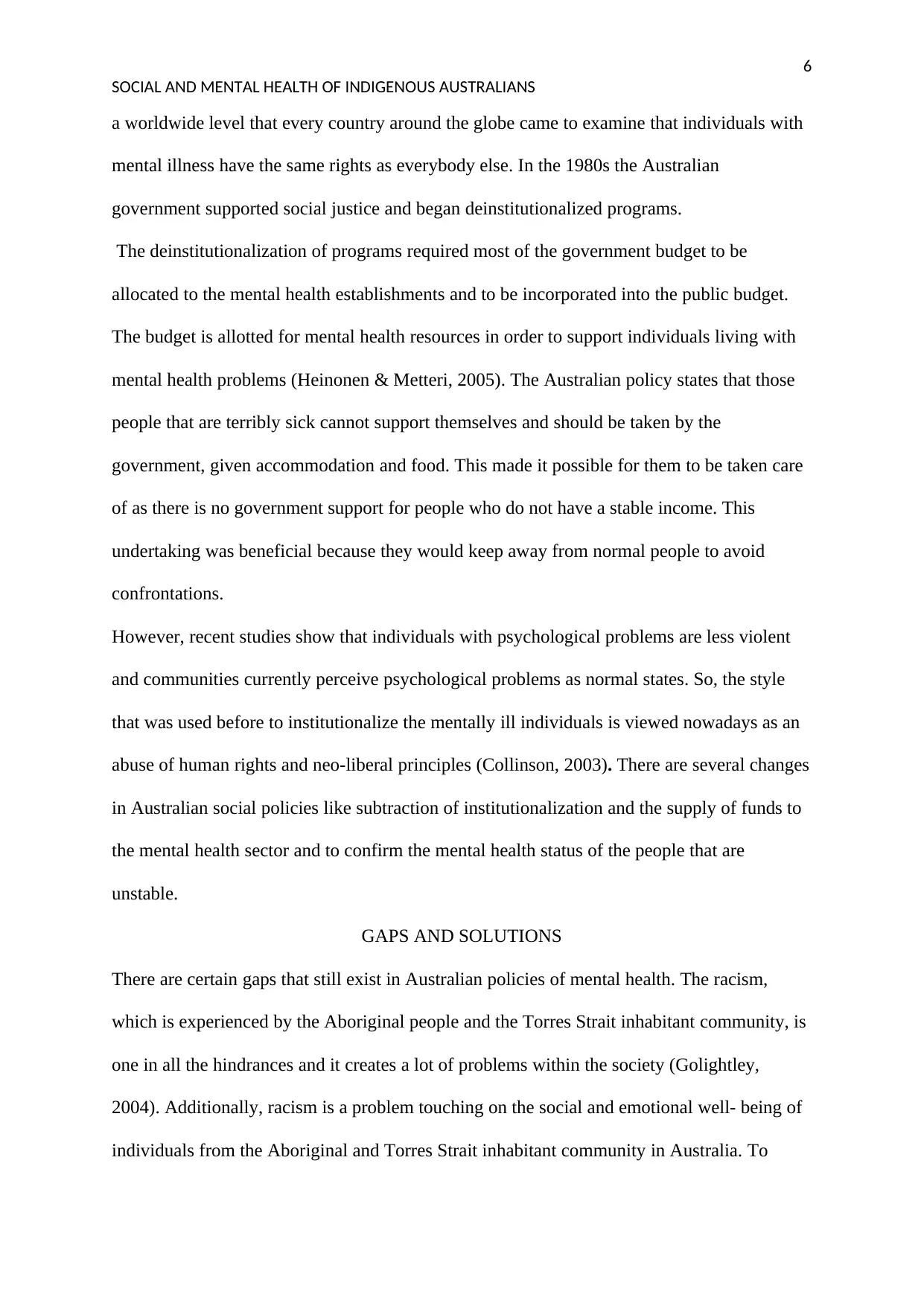
6
SOCIAL AND MENTAL HEALTH OF INDIGENOUS AUSTRALIANS
a worldwide level that every country around the globe came to examine that individuals with
mental illness have the same rights as everybody else. In the 1980s the Australian
government supported social justice and began deinstitutionalized programs.
The deinstitutionalization of programs required most of the government budget to be
allocated to the mental health establishments and to be incorporated into the public budget.
The budget is allotted for mental health resources in order to support individuals living with
mental health problems (Heinonen & Metteri, 2005). The Australian policy states that those
people that are terribly sick cannot support themselves and should be taken by the
government, given accommodation and food. This made it possible for them to be taken care
of as there is no government support for people who do not have a stable income. This
undertaking was beneficial because they would keep away from normal people to avoid
confrontations.
However, recent studies show that individuals with psychological problems are less violent
and communities currently perceive psychological problems as normal states. So, the style
that was used before to institutionalize the mentally ill individuals is viewed nowadays as an
abuse of human rights and neo-liberal principles (Collinson, 2003). There are several changes
in Australian social policies like subtraction of institutionalization and the supply of funds to
the mental health sector and to confirm the mental health status of the people that are
unstable.
GAPS AND SOLUTIONS
There are certain gaps that still exist in Australian policies of mental health. The racism,
which is experienced by the Aboriginal people and the Torres Strait inhabitant community, is
one in all the hindrances and it creates a lot of problems within the society (Golightley,
2004). Additionally, racism is a problem touching on the social and emotional well- being of
individuals from the Aboriginal and Torres Strait inhabitant community in Australia. To
SOCIAL AND MENTAL HEALTH OF INDIGENOUS AUSTRALIANS
a worldwide level that every country around the globe came to examine that individuals with
mental illness have the same rights as everybody else. In the 1980s the Australian
government supported social justice and began deinstitutionalized programs.
The deinstitutionalization of programs required most of the government budget to be
allocated to the mental health establishments and to be incorporated into the public budget.
The budget is allotted for mental health resources in order to support individuals living with
mental health problems (Heinonen & Metteri, 2005). The Australian policy states that those
people that are terribly sick cannot support themselves and should be taken by the
government, given accommodation and food. This made it possible for them to be taken care
of as there is no government support for people who do not have a stable income. This
undertaking was beneficial because they would keep away from normal people to avoid
confrontations.
However, recent studies show that individuals with psychological problems are less violent
and communities currently perceive psychological problems as normal states. So, the style
that was used before to institutionalize the mentally ill individuals is viewed nowadays as an
abuse of human rights and neo-liberal principles (Collinson, 2003). There are several changes
in Australian social policies like subtraction of institutionalization and the supply of funds to
the mental health sector and to confirm the mental health status of the people that are
unstable.
GAPS AND SOLUTIONS
There are certain gaps that still exist in Australian policies of mental health. The racism,
which is experienced by the Aboriginal people and the Torres Strait inhabitant community, is
one in all the hindrances and it creates a lot of problems within the society (Golightley,
2004). Additionally, racism is a problem touching on the social and emotional well- being of
individuals from the Aboriginal and Torres Strait inhabitant community in Australia. To
⊘ This is a preview!⊘
Do you want full access?
Subscribe today to unlock all pages.

Trusted by 1+ million students worldwide
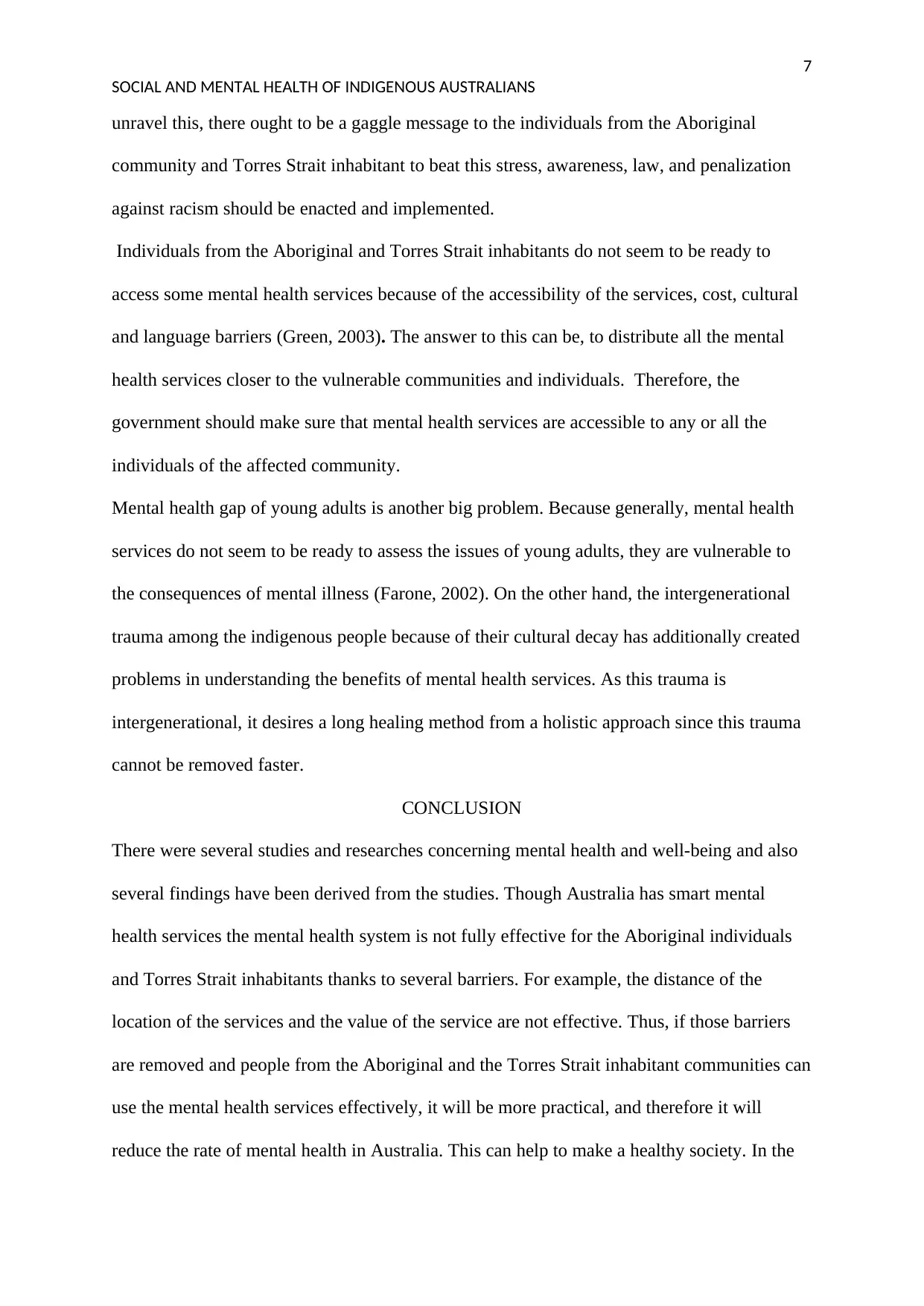
7
SOCIAL AND MENTAL HEALTH OF INDIGENOUS AUSTRALIANS
unravel this, there ought to be a gaggle message to the individuals from the Aboriginal
community and Torres Strait inhabitant to beat this stress, awareness, law, and penalization
against racism should be enacted and implemented.
Individuals from the Aboriginal and Torres Strait inhabitants do not seem to be ready to
access some mental health services because of the accessibility of the services, cost, cultural
and language barriers (Green, 2003). The answer to this can be, to distribute all the mental
health services closer to the vulnerable communities and individuals. Therefore, the
government should make sure that mental health services are accessible to any or all the
individuals of the affected community.
Mental health gap of young adults is another big problem. Because generally, mental health
services do not seem to be ready to assess the issues of young adults, they are vulnerable to
the consequences of mental illness (Farone, 2002). On the other hand, the intergenerational
trauma among the indigenous people because of their cultural decay has additionally created
problems in understanding the benefits of mental health services. As this trauma is
intergenerational, it desires a long healing method from a holistic approach since this trauma
cannot be removed faster.
CONCLUSION
There were several studies and researches concerning mental health and well-being and also
several findings have been derived from the studies. Though Australia has smart mental
health services the mental health system is not fully effective for the Aboriginal individuals
and Torres Strait inhabitants thanks to several barriers. For example, the distance of the
location of the services and the value of the service are not effective. Thus, if those barriers
are removed and people from the Aboriginal and the Torres Strait inhabitant communities can
use the mental health services effectively, it will be more practical, and therefore it will
reduce the rate of mental health in Australia. This can help to make a healthy society. In the
SOCIAL AND MENTAL HEALTH OF INDIGENOUS AUSTRALIANS
unravel this, there ought to be a gaggle message to the individuals from the Aboriginal
community and Torres Strait inhabitant to beat this stress, awareness, law, and penalization
against racism should be enacted and implemented.
Individuals from the Aboriginal and Torres Strait inhabitants do not seem to be ready to
access some mental health services because of the accessibility of the services, cost, cultural
and language barriers (Green, 2003). The answer to this can be, to distribute all the mental
health services closer to the vulnerable communities and individuals. Therefore, the
government should make sure that mental health services are accessible to any or all the
individuals of the affected community.
Mental health gap of young adults is another big problem. Because generally, mental health
services do not seem to be ready to assess the issues of young adults, they are vulnerable to
the consequences of mental illness (Farone, 2002). On the other hand, the intergenerational
trauma among the indigenous people because of their cultural decay has additionally created
problems in understanding the benefits of mental health services. As this trauma is
intergenerational, it desires a long healing method from a holistic approach since this trauma
cannot be removed faster.
CONCLUSION
There were several studies and researches concerning mental health and well-being and also
several findings have been derived from the studies. Though Australia has smart mental
health services the mental health system is not fully effective for the Aboriginal individuals
and Torres Strait inhabitants thanks to several barriers. For example, the distance of the
location of the services and the value of the service are not effective. Thus, if those barriers
are removed and people from the Aboriginal and the Torres Strait inhabitant communities can
use the mental health services effectively, it will be more practical, and therefore it will
reduce the rate of mental health in Australia. This can help to make a healthy society. In the
Paraphrase This Document
Need a fresh take? Get an instant paraphrase of this document with our AI Paraphraser
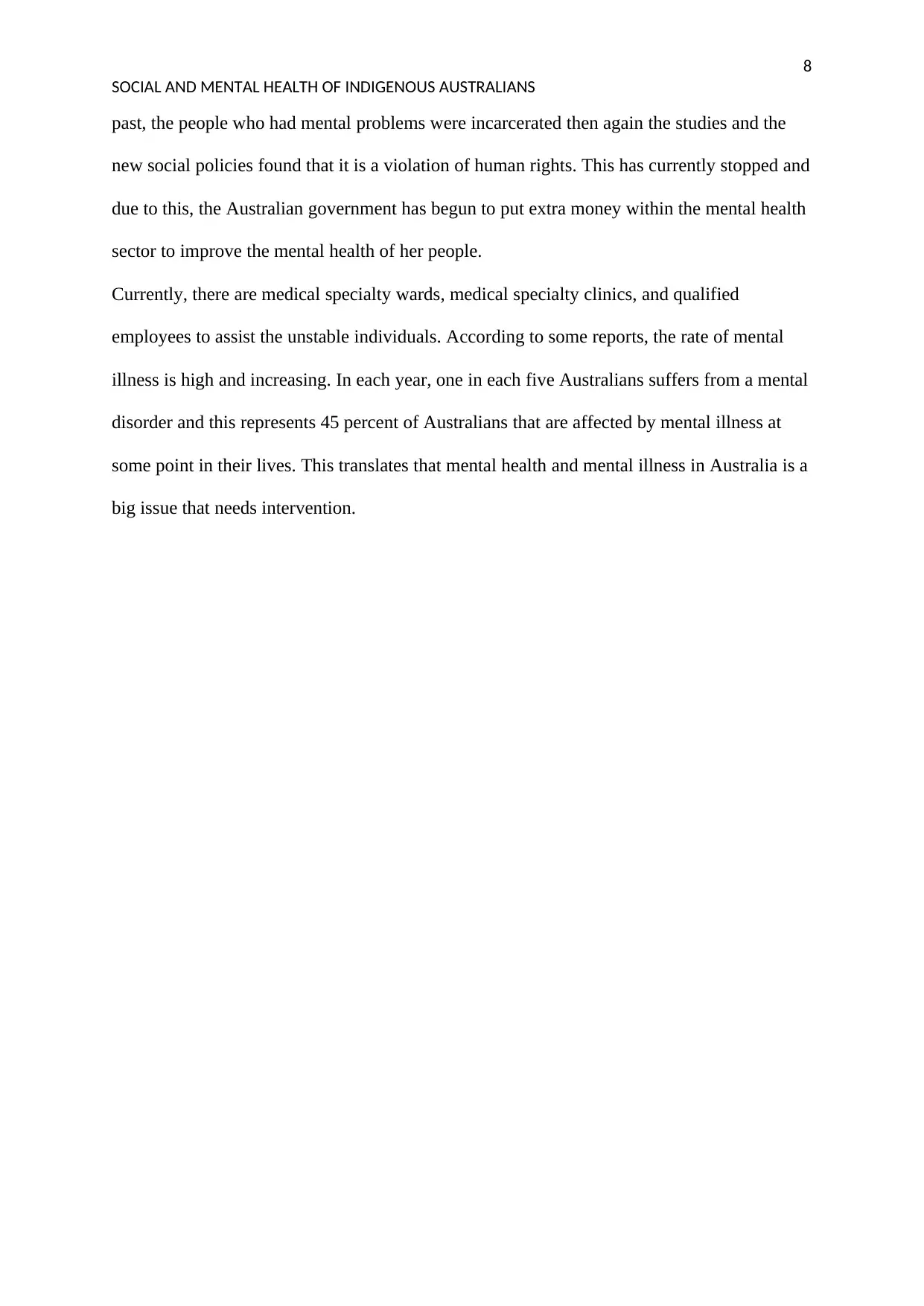
8
SOCIAL AND MENTAL HEALTH OF INDIGENOUS AUSTRALIANS
past, the people who had mental problems were incarcerated then again the studies and the
new social policies found that it is a violation of human rights. This has currently stopped and
due to this, the Australian government has begun to put extra money within the mental health
sector to improve the mental health of her people.
Currently, there are medical specialty wards, medical specialty clinics, and qualified
employees to assist the unstable individuals. According to some reports, the rate of mental
illness is high and increasing. In each year, one in each five Australians suffers from a mental
disorder and this represents 45 percent of Australians that are affected by mental illness at
some point in their lives. This translates that mental health and mental illness in Australia is a
big issue that needs intervention.
SOCIAL AND MENTAL HEALTH OF INDIGENOUS AUSTRALIANS
past, the people who had mental problems were incarcerated then again the studies and the
new social policies found that it is a violation of human rights. This has currently stopped and
due to this, the Australian government has begun to put extra money within the mental health
sector to improve the mental health of her people.
Currently, there are medical specialty wards, medical specialty clinics, and qualified
employees to assist the unstable individuals. According to some reports, the rate of mental
illness is high and increasing. In each year, one in each five Australians suffers from a mental
disorder and this represents 45 percent of Australians that are affected by mental illness at
some point in their lives. This translates that mental health and mental illness in Australia is a
big issue that needs intervention.
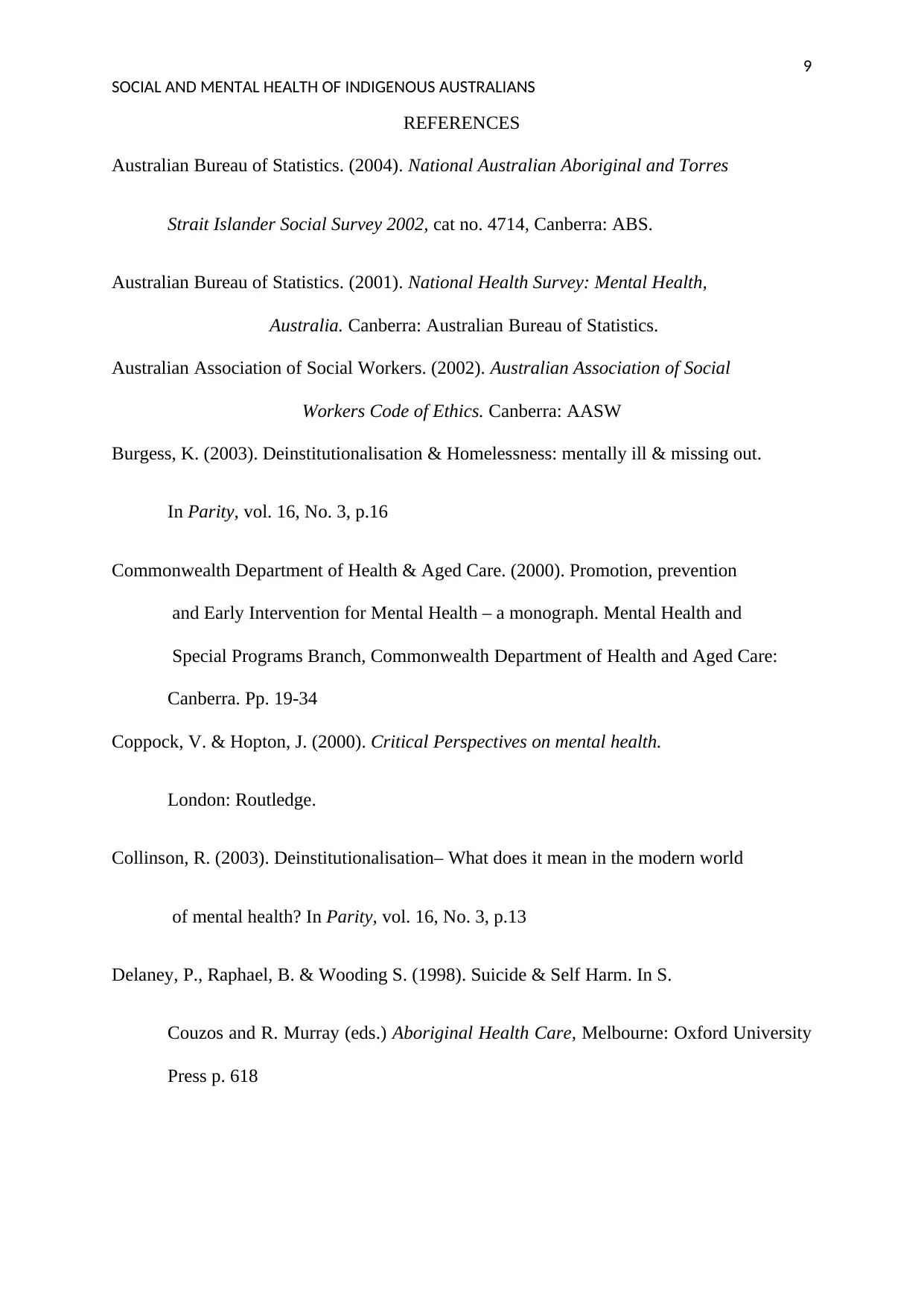
9
SOCIAL AND MENTAL HEALTH OF INDIGENOUS AUSTRALIANS
REFERENCES
Australian Bureau of Statistics. (2004). National Australian Aboriginal and Torres
Strait Islander Social Survey 2002, cat no. 4714, Canberra: ABS.
Australian Bureau of Statistics. (2001). National Health Survey: Mental Health,
Australia. Canberra: Australian Bureau of Statistics.
Australian Association of Social Workers. (2002). Australian Association of Social
Workers Code of Ethics. Canberra: AASW
Burgess, K. (2003). Deinstitutionalisation & Homelessness: mentally ill & missing out.
In Parity, vol. 16, No. 3, p.16
Commonwealth Department of Health & Aged Care. (2000). Promotion, prevention
and Early Intervention for Mental Health – a monograph. Mental Health and
Special Programs Branch, Commonwealth Department of Health and Aged Care:
Canberra. Pp. 19-34
Coppock, V. & Hopton, J. (2000). Critical Perspectives on mental health.
London: Routledge.
Collinson, R. (2003). Deinstitutionalisation– What does it mean in the modern world
of mental health? In Parity, vol. 16, No. 3, p.13
Delaney, P., Raphael, B. & Wooding S. (1998). Suicide & Self Harm. In S.
Couzos and R. Murray (eds.) Aboriginal Health Care, Melbourne: Oxford University
Press p. 618
SOCIAL AND MENTAL HEALTH OF INDIGENOUS AUSTRALIANS
REFERENCES
Australian Bureau of Statistics. (2004). National Australian Aboriginal and Torres
Strait Islander Social Survey 2002, cat no. 4714, Canberra: ABS.
Australian Bureau of Statistics. (2001). National Health Survey: Mental Health,
Australia. Canberra: Australian Bureau of Statistics.
Australian Association of Social Workers. (2002). Australian Association of Social
Workers Code of Ethics. Canberra: AASW
Burgess, K. (2003). Deinstitutionalisation & Homelessness: mentally ill & missing out.
In Parity, vol. 16, No. 3, p.16
Commonwealth Department of Health & Aged Care. (2000). Promotion, prevention
and Early Intervention for Mental Health – a monograph. Mental Health and
Special Programs Branch, Commonwealth Department of Health and Aged Care:
Canberra. Pp. 19-34
Coppock, V. & Hopton, J. (2000). Critical Perspectives on mental health.
London: Routledge.
Collinson, R. (2003). Deinstitutionalisation– What does it mean in the modern world
of mental health? In Parity, vol. 16, No. 3, p.13
Delaney, P., Raphael, B. & Wooding S. (1998). Suicide & Self Harm. In S.
Couzos and R. Murray (eds.) Aboriginal Health Care, Melbourne: Oxford University
Press p. 618
⊘ This is a preview!⊘
Do you want full access?
Subscribe today to unlock all pages.

Trusted by 1+ million students worldwide
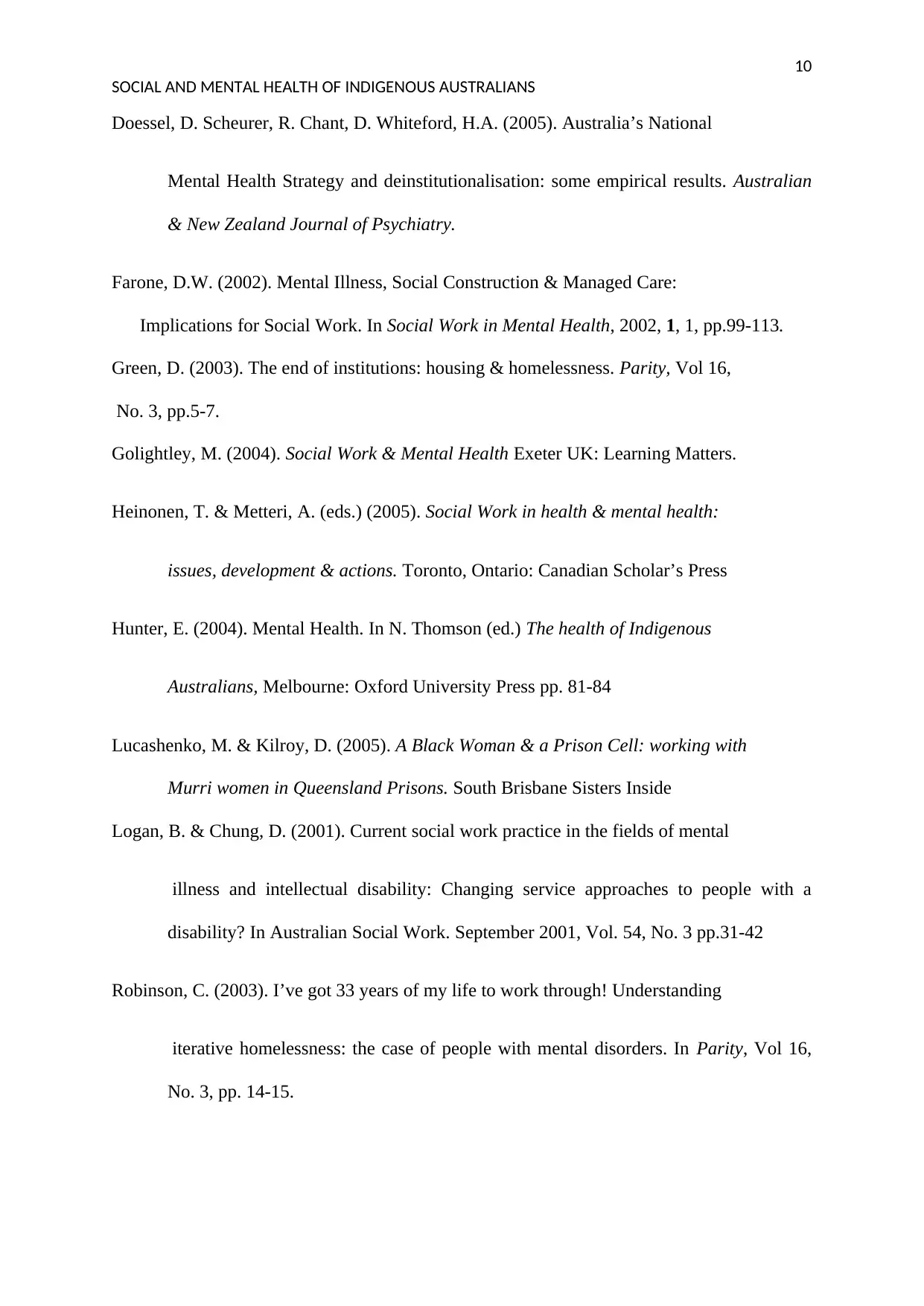
10
SOCIAL AND MENTAL HEALTH OF INDIGENOUS AUSTRALIANS
Doessel, D. Scheurer, R. Chant, D. Whiteford, H.A. (2005). Australia’s National
Mental Health Strategy and deinstitutionalisation: some empirical results. Australian
& New Zealand Journal of Psychiatry.
Farone, D.W. (2002). Mental Illness, Social Construction & Managed Care:
Implications for Social Work. In Social Work in Mental Health, 2002, 1, 1, pp.99-113.
Green, D. (2003). The end of institutions: housing & homelessness. Parity, Vol 16,
No. 3, pp.5-7.
Golightley, M. (2004). Social Work & Mental Health Exeter UK: Learning Matters.
Heinonen, T. & Metteri, A. (eds.) (2005). Social Work in health & mental health:
issues, development & actions. Toronto, Ontario: Canadian Scholar’s Press
Hunter, E. (2004). Mental Health. In N. Thomson (ed.) The health of Indigenous
Australians, Melbourne: Oxford University Press pp. 81-84
Lucashenko, M. & Kilroy, D. (2005). A Black Woman & a Prison Cell: working with
Murri women in Queensland Prisons. South Brisbane Sisters Inside
Logan, B. & Chung, D. (2001). Current social work practice in the fields of mental
illness and intellectual disability: Changing service approaches to people with a
disability? In Australian Social Work. September 2001, Vol. 54, No. 3 pp.31-42
Robinson, C. (2003). I’ve got 33 years of my life to work through! Understanding
iterative homelessness: the case of people with mental disorders. In Parity, Vol 16,
No. 3, pp. 14-15.
SOCIAL AND MENTAL HEALTH OF INDIGENOUS AUSTRALIANS
Doessel, D. Scheurer, R. Chant, D. Whiteford, H.A. (2005). Australia’s National
Mental Health Strategy and deinstitutionalisation: some empirical results. Australian
& New Zealand Journal of Psychiatry.
Farone, D.W. (2002). Mental Illness, Social Construction & Managed Care:
Implications for Social Work. In Social Work in Mental Health, 2002, 1, 1, pp.99-113.
Green, D. (2003). The end of institutions: housing & homelessness. Parity, Vol 16,
No. 3, pp.5-7.
Golightley, M. (2004). Social Work & Mental Health Exeter UK: Learning Matters.
Heinonen, T. & Metteri, A. (eds.) (2005). Social Work in health & mental health:
issues, development & actions. Toronto, Ontario: Canadian Scholar’s Press
Hunter, E. (2004). Mental Health. In N. Thomson (ed.) The health of Indigenous
Australians, Melbourne: Oxford University Press pp. 81-84
Lucashenko, M. & Kilroy, D. (2005). A Black Woman & a Prison Cell: working with
Murri women in Queensland Prisons. South Brisbane Sisters Inside
Logan, B. & Chung, D. (2001). Current social work practice in the fields of mental
illness and intellectual disability: Changing service approaches to people with a
disability? In Australian Social Work. September 2001, Vol. 54, No. 3 pp.31-42
Robinson, C. (2003). I’ve got 33 years of my life to work through! Understanding
iterative homelessness: the case of people with mental disorders. In Parity, Vol 16,
No. 3, pp. 14-15.
Paraphrase This Document
Need a fresh take? Get an instant paraphrase of this document with our AI Paraphraser
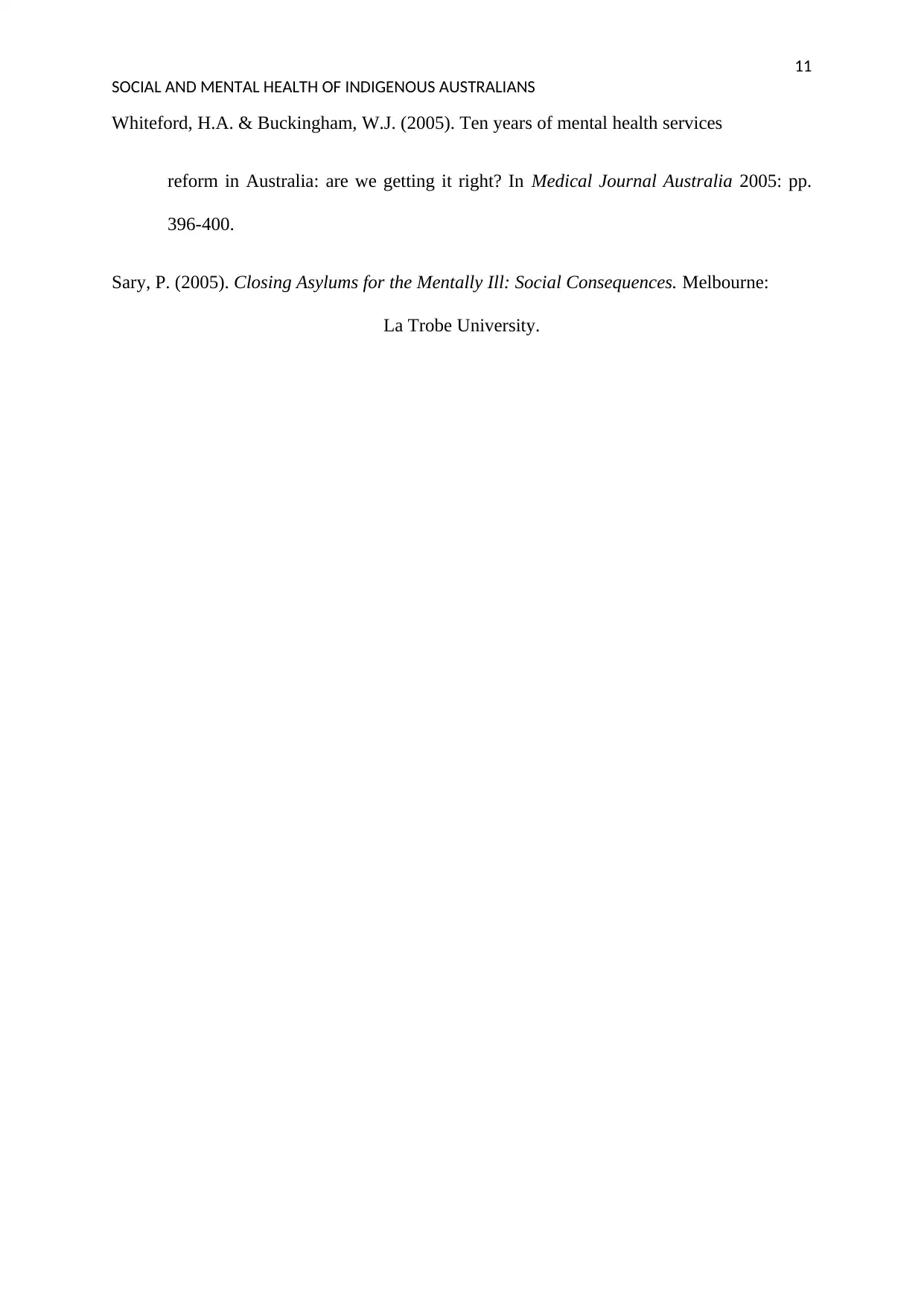
11
SOCIAL AND MENTAL HEALTH OF INDIGENOUS AUSTRALIANS
Whiteford, H.A. & Buckingham, W.J. (2005). Ten years of mental health services
reform in Australia: are we getting it right? In Medical Journal Australia 2005: pp.
396-400.
Sary, P. (2005). Closing Asylums for the Mentally Ill: Social Consequences. Melbourne:
La Trobe University.
SOCIAL AND MENTAL HEALTH OF INDIGENOUS AUSTRALIANS
Whiteford, H.A. & Buckingham, W.J. (2005). Ten years of mental health services
reform in Australia: are we getting it right? In Medical Journal Australia 2005: pp.
396-400.
Sary, P. (2005). Closing Asylums for the Mentally Ill: Social Consequences. Melbourne:
La Trobe University.
1 out of 11
Related Documents
Your All-in-One AI-Powered Toolkit for Academic Success.
+13062052269
info@desklib.com
Available 24*7 on WhatsApp / Email
![[object Object]](/_next/static/media/star-bottom.7253800d.svg)
Unlock your academic potential
Copyright © 2020–2025 A2Z Services. All Rights Reserved. Developed and managed by ZUCOL.




